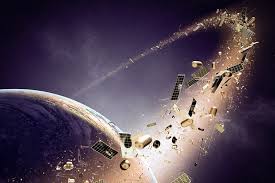The Humankind has degraded the very serene Nature he was gifted with.
Man belongs to Earth but Earth does not belong only to Man, yet Humans exploited it in every way possible.
His destructive expanse has even spilled onto the lesser-touched Space.
It will not be difficult to imagine that there’s a whole host of man-made objects(US and Russia have estimated the numbers to be in trillions), floating around thousands of miles away in space. All is the very legacy of us, Humans.
Space junk covers all sorts of things, such as matter leftover from previous space missions, objects sent up into space from Earth.
Even strange items like copper needles, Lego figurines, dead animals(including over 30 Monkeys and Laika, the dog etc), astronaut’s family portraits and even Star Trek creator’s ashes.
The space agencies have time and again highlighted the ‘critical’ abundance of space junk that has reached abnormal levels.
ESA said: “There are already 17,000 trackable objects larger than a coffee cup, which threaten working missions with catastrophic collision. Even a 1cm nut could hit with the force of a hand grenade.”
Orbits of 800-965 km altitude that pass over the poles are worst affected by this debris because these already contain many of the 5,000+ satellites launched by humanity since the space travel began i.e. much of this debris roams within 1,250 miles of Earth’s surface.
How long a piece of space debris takes to fall back to Earth depends on its altitude.
They have even aimed at removing 5-10 large satellites from space per year that would only be enough to stop the debris cloud growing.
Cognisance of the growing problem:
It began in 2009, where it was seen some 500 miles above Siberia. The two satellites collided at approximately 22,300 mph, bursting into a cloud of thousands of pieces of debris.
The collided objects in this high-speed accident were the inactive Russian satellite Cosmos 2251 and the active U.S.-based communication satellite Iridium 33.
The catastrophic end was the first such incidence of satellite collision in space, and a startling reminder of the growing problem of space junk.
Avoidance of such hit and miss:
Since the amount of debris in space threatens both crewed and uncrewed spaceflight, a probability is created for every active object.
For a space shuttle, the risk is 1 in 300
For missions to the Hubble Space Telescope, the risk was 1 in 185.
The risk of a hit with the International Space Station (ISS) is 1 in 100000.
In such a case, the astronauts perform a debris avoidance maneuver in which the ISS’s orbit is raised to avoid the collision.
With the increasing amount of space debris, the fears are persistent that such collisions could set off a chain reaction (called the Kessler syndrome after American scientist Donald Kessler).
Solutions:
Consequently, different Countries began protecting their respective satellites and thereby tracking these inactive junks to be successfully avoided.
As of 2020, the United States Space Surveillance Network was tracking more than 14,000 pieces of space debris larger than 10 cm (4 inches) across.
British satellite RemoveDEBRIS, which was launched in 2018 and deployed from the ISS, tested two different technologies for removing space debris:
capture with a net
capture with a harpoon.
SPACE-TRACK.org is a public access repository maintained by the U.S. defence wing.
It tracks space activity, i.e. incoming “space debris”.
Clearing the space junk can also be done using Artificial Intelligence by using robotic arms of a capture rocket to grasp the junk and pull it back into the Earth’s atmosphere.
One can develop deep learning algorithms to estimate the target from video sequences and images taken in space.
On similar lines, Network for Space Object Tracking and Analysis (NETRA) has been launched by ISRO(space and military).
It will safeguard India’s 50 functional satellites in space using an on-ground network of telescopes and radars under the Directorate of Space Situational Awareness and Management.
Just like we are ‘mission clean’ on Earth, we need to pick up our litter from space too.





